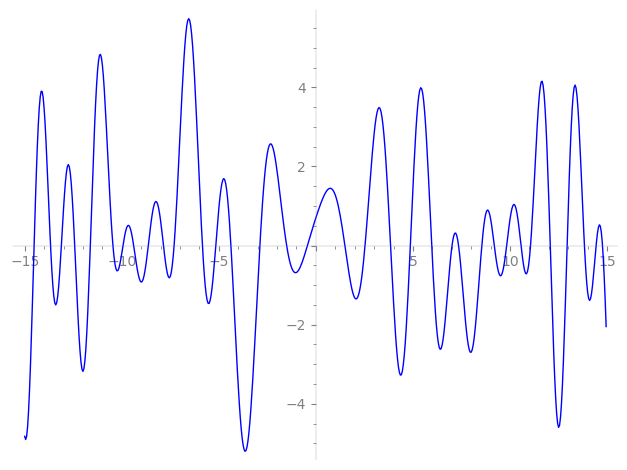| L(s) = 1 | − 1.34·2-s − 0.184·4-s + (1.26 − 2.19i)5-s + 2.94·8-s + (−1.70 + 2.95i)10-s + (0.233 + 0.405i)11-s + (−2.91 − 5.04i)13-s − 3.59·16-s + (1.93 − 3.35i)17-s + (1.09 + 1.89i)19-s + (−0.233 + 0.405i)20-s + (−0.315 − 0.545i)22-s + (−0.0530 + 0.0918i)23-s + (−0.705 − 1.22i)25-s + (3.92 + 6.79i)26-s + ⋯ |
| L(s) = 1 | − 0.952·2-s − 0.0923·4-s + (0.566 − 0.980i)5-s + 1.04·8-s + (−0.539 + 0.934i)10-s + (0.0705 + 0.122i)11-s + (−0.807 − 1.39i)13-s − 0.899·16-s + (0.470 − 0.814i)17-s + (0.250 + 0.434i)19-s + (−0.0523 + 0.0906i)20-s + (−0.0672 − 0.116i)22-s + (−0.0110 + 0.0191i)23-s + (−0.141 − 0.244i)25-s + (0.769 + 1.33i)26-s + ⋯ |
Λ(s)=(=(1323s/2ΓC(s)L(s)(−0.678+0.734i)Λ(2−s)
Λ(s)=(=(1323s/2ΓC(s+1/2)L(s)(−0.678+0.734i)Λ(1−s)
| Degree: |
2 |
| Conductor: |
1323
= 33⋅72
|
| Sign: |
−0.678+0.734i
|
| Analytic conductor: |
10.5642 |
| Root analytic conductor: |
3.25026 |
| Motivic weight: |
1 |
| Rational: |
no |
| Arithmetic: |
yes |
| Character: |
χ1323(802,⋅)
|
| Primitive: |
yes
|
| Self-dual: |
no
|
| Analytic rank: |
0
|
| Selberg data: |
(2, 1323, ( :1/2), −0.678+0.734i)
|
Particular Values
| L(1) |
≈ |
0.7060579436 |
| L(21) |
≈ |
0.7060579436 |
| L(23) |
|
not available |
| L(1) |
|
not available |
L(s)=p∏Fp(p−s)−1 | p | Fp(T) |
|---|
| bad | 3 | 1 |
| 7 | 1 |
| good | 2 | 1+1.34T+2T2 |
| 5 | 1+(−1.26+2.19i)T+(−2.5−4.33i)T2 |
| 11 | 1+(−0.233−0.405i)T+(−5.5+9.52i)T2 |
| 13 | 1+(2.91+5.04i)T+(−6.5+11.2i)T2 |
| 17 | 1+(−1.93+3.35i)T+(−8.5−14.7i)T2 |
| 19 | 1+(−1.09−1.89i)T+(−9.5+16.4i)T2 |
| 23 | 1+(0.0530−0.0918i)T+(−11.5−19.9i)T2 |
| 29 | 1+(−4.39+7.60i)T+(−14.5−25.1i)T2 |
| 31 | 1+7.68T+31T2 |
| 37 | 1+(−3.84−6.65i)T+(−18.5+32.0i)T2 |
| 41 | 1+(1.11+1.92i)T+(−20.5+35.5i)T2 |
| 43 | 1+(0.613−1.06i)T+(−21.5−37.2i)T2 |
| 47 | 1−5.33T+47T2 |
| 53 | 1+(0.358−0.620i)T+(−26.5−45.8i)T2 |
| 59 | 1+0.736T+59T2 |
| 61 | 1−0.958T+61T2 |
| 67 | 1+9.63T+67T2 |
| 71 | 1+13.2T+71T2 |
| 73 | 1+(−5.13+8.89i)T+(−36.5−63.2i)T2 |
| 79 | 1+12.6T+79T2 |
| 83 | 1+(1.36−2.36i)T+(−41.5−71.8i)T2 |
| 89 | 1+(4.05+7.02i)T+(−44.5+77.0i)T2 |
| 97 | 1+(−6.80+11.7i)T+(−48.5−84.0i)T2 |
| show more | |
| show less | |
L(s)=p∏ j=1∏2(1−αj,pp−s)−1
Imaginary part of the first few zeros on the critical line
−9.386736093297137183208907528362, −8.632920556891456090505401288560, −7.85003893481137941710526620717, −7.30465567411923526402838435651, −5.84431803504516293134210128832, −5.15647210108345494806655841704, −4.37733122918936761059266255226, −2.88553098963996835285390837704, −1.50691906677424877124384919067, −0.43651933964689686108467198923,
1.49376423775150891738678551928, 2.53019707865550335147930614360, 3.84639525545306640528622805239, 4.86380285581696211941548942749, 5.96580661870092822463994557396, 7.01159818697596216983890284844, 7.34765527993913817589122741752, 8.546419604787823953684772182599, 9.189273954470415373296145774940, 9.826699419650117911064212539462

